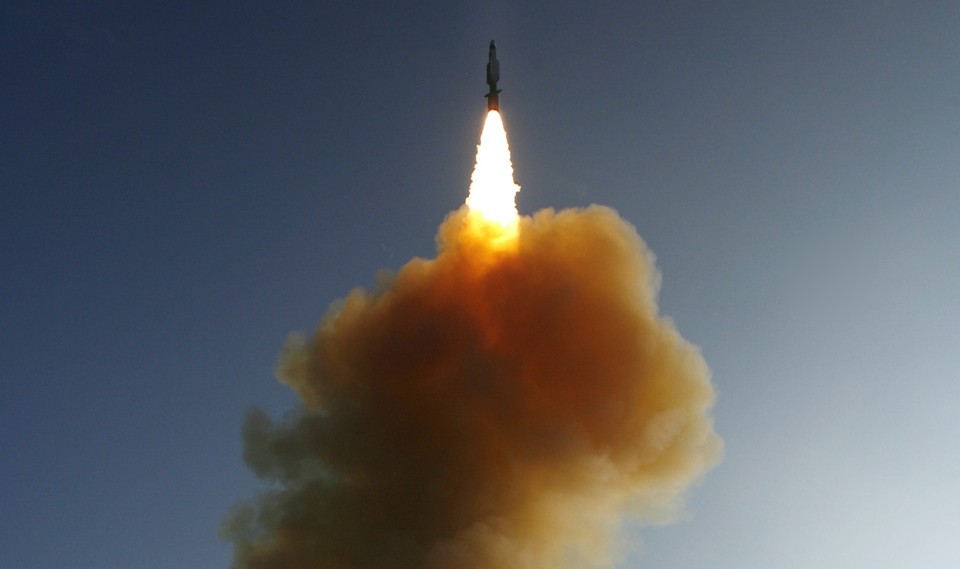One hundred miles above the Earth’s surface, orbiting the planet at thousands of miles per hour, the six people aboard the International Space Station enjoy a perfect isolation from the chaos of earthly conflict. Outer space has never been a military battleground. But that may not last forever. The debate in Congress over whether to create a Space Corps comes at a time when governments around the world are engaged in a bigger international struggle over how militaries should operate in space. Fundamental changes are already underway. No longer confined to the fiction shelf, space warfare is likely on the horizon.
While agreements for how to operate in other international domains, like the open sea, airspace, and even cyberspace, have already been established, the major space powers—the United States, Russia, and China—have not agreed upon a rulebook outlining what constitutes bad behavior in space. It’s presumed that International Humanitarian Law would apply in outer space—protecting the civilian astronauts aboard the International Space Station—but it’s unclear whether damaging civilian satellites or the space environment itself is covered under the agreement. With only a limited history of dangerous behavior to study, and few, outdated guidelines in place, a war in space would be a war with potentially more consequences, but far fewer rules, than one on Earth.
Although there has never been a military conflict in space, the history of human activity above our atmosphere is not entirely benign. In 1962, the United States detonated a 1.4 megaton nuclear weapon 250 miles above the Earth’s surface. The blast destroyed approximately one third of satellites in orbit and poisoned the most used region of space with radiation that lasted for years. Although the United States, Russia, and others soon agreed to a treaty to prevent another nuclear test in space, China and North Korea never signed it. In 2007, China tested an anti-satellite weapon, a conventionally-armed missile designed to target and destroy a satellite in orbit. In the process, it annihilated an old Chinese weather satellite and created high-velocity shrapnel that still threatens other satellites. Even though demonstrations like this have consequences for everyone, countries are free to carry them out as they see fit. No treaties address this kind of test, the creation of space debris, or the endangerment of other satellites.
The U.S. has the most to lose in a space-based conflict
With by far the most satellites in orbit, the U.S. has the most to gain by establishing norms, but also the most to lose. Almost half of all operational satellites are owned and operated by the United States government or American commercial companies. That’s twice as many as Russia and China, combined. Space may seem distant, but what happens there affects our everyday lives on the ground. When we use our phones to plan a trip, we depend on American GPS satellites to guide us. When the U.S. military deploys troops overseas, satellite communications connect forces on the ground to control centers. When North Korea launches an intercontinental ballistic missile, the U.S. and its allies depend on early-warning satellites to detect it.
On one hand, if the global space powers agreed to put limits on space-based weapons and other related technologies, it could make space safer for everyone. But because the U.S. may have spent time and resources developing exactly the type of weapons that a code of conduct would ban, it could also curtail the most advanced space-based developments, erasing years of research and progress.
There are more players in space—and less consensus
In the first space age, from the launch of the first human-made satellite in 1957 through the fall of the Soviet Union, the United States and the USSR were responsible for over 90 percent of all satellites. Their race to perfect space technology, dominated by both national security interests and scientific discovery, far outpaced everyone else. The second space age, from 1990 to today, looks remarkably different. Now, more satellites are operated by private companies than militaries, and more space launches and new satellites come from countries other than the United States and Russia. More players in space—particularly more unpredictable players—means more opportunities for aggressive behavior, like developing anti-satellite technologies or hacking satellite communications. Countries like Iran or North Korea that are newer to space can choose to operate in a way we’ve never seen before. And if their nuclear programs on Earth are any guide, they could pose serious threats if left unchecked.
Space Launches by Country in the First and Second Space Ages. The Outer Space Treaty of 1967 was written to govern a space era far different from the one seen today. Since 2014, a majority of space launches—civil, commercial, and military—have come from outside of the United States and Russia. Adapted from “Escalation and Deterrence in the Second Space Age,” Center for Strategic and International Studies (October 2017).
Efforts have been made to create a modern-day space rulebook, but so far none have gained traction. In 2008, when Russia and China both proposed norms of behavior, the United States refused to sign on. Similarly, when the United States supported a 2014 European Union proposal to govern the use of conventional weapons in orbit, Russia and China didn’t agree with the terms.
Since the congressional debate about a Space Corps, people have been taking the prospect of a war in space seriously, in a way we haven’t seen before. Now we should start talking about how to avoid that war. To prevent conflict in the upper atmosphere, all potential adversaries—the United States, China, North Korea, Iran, Russia, the EU—need to align, and agree on norms of behavior. They need rules.

No comments:
Post a Comment